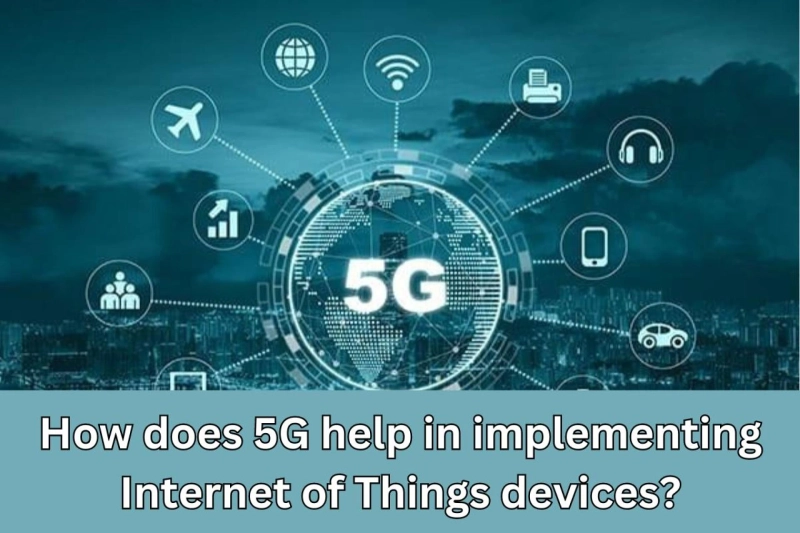Introduction:
The advent of 5G technology has ushered in a new era of connectivity, bringing with it the promise of faster speeds, lower latency, and a massive capacity to support an unprecedented number of devices. In this blog, we will explore how 5G plays a pivotal role in advancing the implementation of Internet of Things (IoT) devices, revolutionizing the way our world communicates and operates.
The 5G Revolution: A Catalyst for IoT Growth
Unprecedented Speeds:5G boasts blazing-fast data speeds, a quantum leap beyond its predecessors. This high-speed connectivity is essential for IoT devices that rely on real-time data exchange, enabling them to process and transmit information swiftly and efficiently.
Reduced latency is a hallmark of 5G, minimizing the delay between the initiation of a command and its execution. This low latency is critical for applications like autonomous vehicles, smart cities, and healthcare devices, where split-second decisions can have profound implications.
Enabling Massive Device Connectivity
Enhanced Capacity:5G's increased capacity allows for the simultaneous connection of a vast number of devices within a confined geographical area. This is a game-changer for IoT, as it supports the proliferation of smart devices in homes, cities, industries, and beyond.
One of 5G's innovative features is network slicing, which enables the creation of virtualized, customized networks tailored to specific IoT applications. This ensures that critical applications receive the necessary resources and priority, optimizing overall network efficiency.
IoT Applications Empowered by 5G
Smart Cities:5G facilitates the deployment of IoT sensors and devices in urban environments, fostering the creation of smart cities. From intelligent traffic management to efficient waste disposal, the seamless connectivity provided by 5G is instrumental in optimizing urban living.
In healthcare, 5G enables the implementation of IoT devices for remote patient monitoring, telemedicine, and even robotic surgeries. The combination of high speed and low latency ensures that medical data is transmitted in real-time, enhancing patient care.
Industries leverage 5G to enhance automation and efficiency. With a multitude of sensors and devices connected through 5G networks, industrial processes can be monitored, controlled, and optimized in real-time, leading to increased productivity and cost savings.
Security and Privacy Considerations
Network Security:The expansive network of IoT devices demands robust security measures. 5G introduces improved security protocols, including encryption and authentication, to safeguard the integrity of data transmitted between devices.
5G facilitates edge computing, allowing data to be processed closer to the source, reducing the need for centralized data centers. This not only enhances speed but also addresses privacy concerns by minimizing the distance data travels.
The Future of IoT with 5G
As 5G continues to roll out globally, the marriage of this advanced connectivity with IoT devices is poised to unlock unparalleled innovation. From smart homes to entire smart ecosystems, the synergy between 5G and IoT promises a future where our devices seamlessly collaborate to create a more connected, intelligent, and efficient world.
Conclusion: A Synergistic Future Unveiled
The implementation of IoT devices has found a formidable ally in 5G technology. As we witness the collaborative evolution of connectivity and intelligence, the possibilities for innovation and progress in diverse sectors are boundless. Embracing this transformative era, we stand at the threshold of a connected world where IoT devices, empowered by 5G, weave a tapestry of efficiency, responsiveness, and unparalleled potential.
FAQs about Internet of Things
What questions can I ask about IoT?
Security:How is the security of the IoT devices ensured?
Are there regular updates and patches to address security vulnerabilities?
Data Privacy:What data is collected by the IoT devices?
How is user privacy protected?
Interoperability:Can IoT devices from different manufacturers work together seamlessly?
Is there a standard protocol for communication between IoT devices?
Scalability:How easily can the IoT system scale to accommodate more devices?
Are there limitations on the number of devices that can be connected?
Power Consumption:How energy-efficient are the IoT devices?
What is the impact on battery life for battery-powered devices?
What is the purpose of the internet of Things?
The purpose of the Internet of Things (IoT) is to enable the connection and communication of everyday physical objects or devices to the internet, allowing them to collect, exchange, and act upon data. This connectivity aims to enhance efficiency, automation, and decision-making in various domains, such as home automation, healthcare, transportation, and industrial processes.What is one of the biggest challenges with the internet of things?
One of the biggest challenges with the Internet of Things (IoT) is ensuring robust security measures. The interconnected nature of IoT devices makes them susceptible to cybersecurity threats, including unauthorized access, data breaches, and potential misuse of personal information. Addressing these security concerns is crucial to building trust and fostering widespread adoption of IoT technologies.Also read
data science institute in delhi
data science training in noida
data analytics courses kolkata



